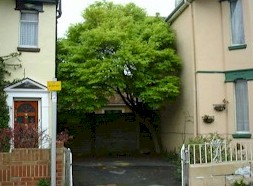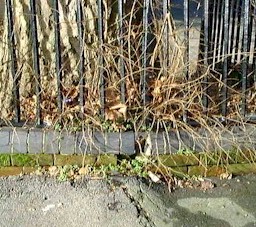 Trees and Buildings
Trees and Buildings
Trees are an important factor within the urban landscape, they break up the hard lines of concrete and brick, provide shade and reduce pollution levels on our roads. They can also cause damage to buildings and structures through direct or indirect root processes.
![]() Direct
Damage to Buildings
Direct
Damage to Buildings
 Trees can cause direct damage to buildings and structures through
direct contact with their roots, branches and trunk. Large established buildings such as
houses are not normally affected; it is the smaller structure such as walls, patios, sheds
and garages which are most at risk. The damage would normally be caused by the annual
increase in girth of the root, branch or stem; as it increases in diameter it lifts or
pushes the structure.
Trees can cause direct damage to buildings and structures through
direct contact with their roots, branches and trunk. Large established buildings such as
houses are not normally affected; it is the smaller structure such as walls, patios, sheds
and garages which are most at risk. The damage would normally be caused by the annual
increase in girth of the root, branch or stem; as it increases in diameter it lifts or
pushes the structure.
The concrete foundations of most modern buildings are able to withstand such tree activity.
Some species of tree can produce new shoots directly from their roots which, as they grow, can cause damage. See Root Suckers.
![]() Indirect Damage
to Buildings
Indirect Damage
to Buildings
Many buildings are located upon a shrinkable soil type (such as some clays); such soils expand and contract in response to their water content. The water content of shrinkable soils increases and decreases in relation to the natural seasonal changes of the British climate. In Winter the shrinkable soil is wetter and increases in volume; in Summer the reverse occurs. These variations are called Seasonal Fluctuations and are quite natural.
The Seasonal Fluctuations are modified by adjacent trees (and other vegetation); these are able to abstract large quantities of water from the surrounding soil which can then increase the shrinkage rate of the localised soil. In some situations where such shrinkage is close to a building, such localised shrinkage can cause a section of building foundation to drop further than a neighbouring unaffected section; the resulting deformation and movement can cause damage i.e Subsidence. This kind of damage can be serious.
Buildings can also experience localised lifting of foundation sections through a process called Heave. In these situations a localised area of shrinkable soil has increased in volume more than a neighbouring area; such localised expansion under a section of foundation, can also cause building damage. Burst water pipes, drainage leaks or the removal of a large area of vegetation (such as a tree) can be a cause of heave.
It is estimated that during the period 1988-1992, building subsidence related claims in Britain exceeded £1.6 billion. Understandably, insurance and mortgage companies have become concerned and many will now request an inspection and report of trees located close to buildings.
Sadly, due to basic Arboricultural ignorance of some building surveyors, many trees are implicated, and removed, as a primary cause of building subsidence when in fact they are not. According to analysis by the London Tree Officers Association (LTOA) 70% of claims made against trees were unfounded (data source AMIUG).
![]() Dealing with
Building Damage
Dealing with
Building Damage
If you suspect that your building is suffering from a form of subsidence then you must immediately contact a qualified structural engineer to inspect the problem and provide a proper report. If trees are located in the vicinity it would be prudent to contact a qualified Arboricultural consultant to carry out an assessment of these.
Early investigation is important. If trees are found to be a cause of such damage, early removal or pruning can often lead to a stabilisation of such damage.
![]() Useful
Contacts and Information Sources
Useful
Contacts and Information Sources
This text is open to modification. If you have an item to add or change please send details.
© 2000 Chris Skellern. AIE. Home | News | A-Z Index | Resources | Contact AIE | Terms of Use